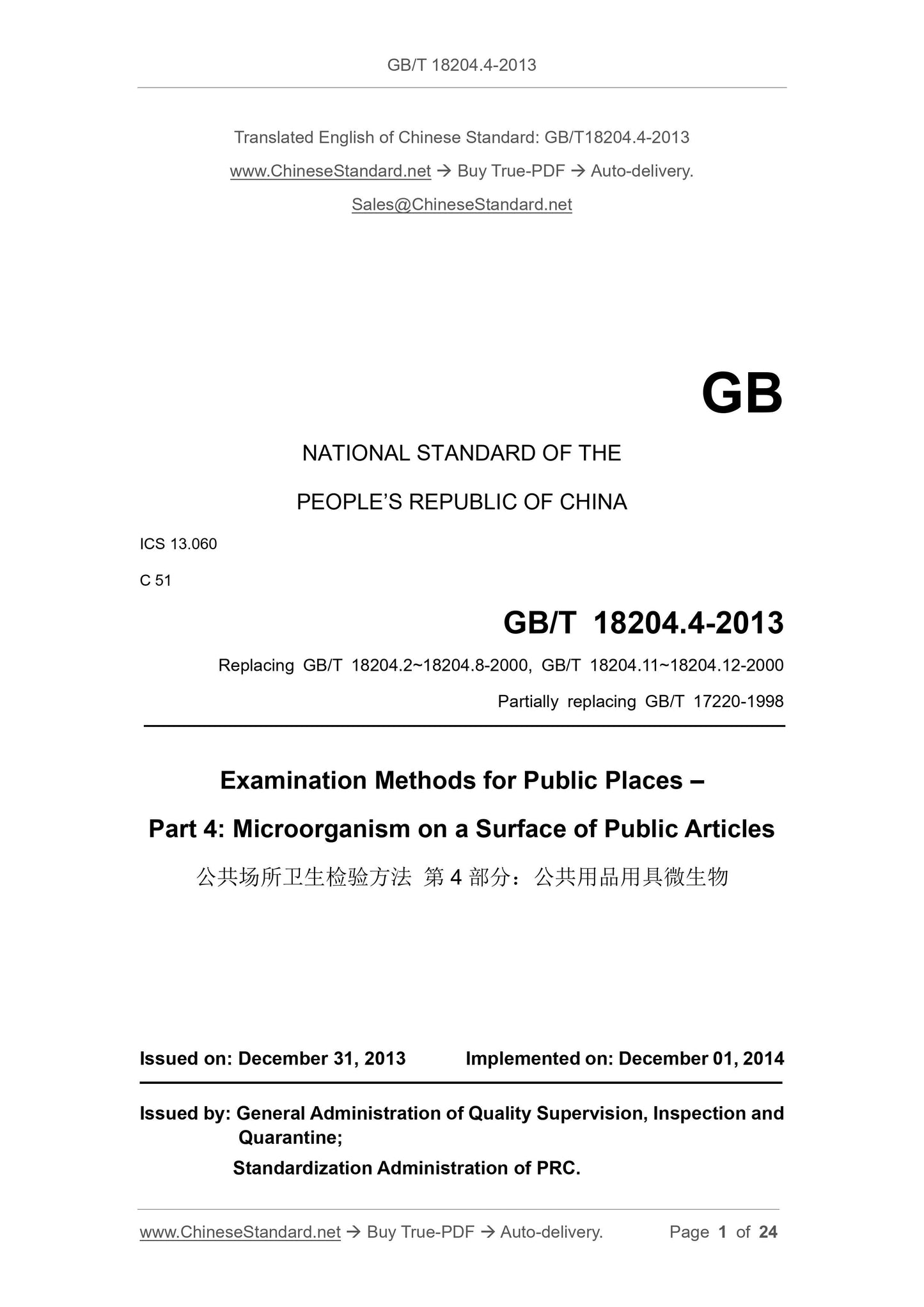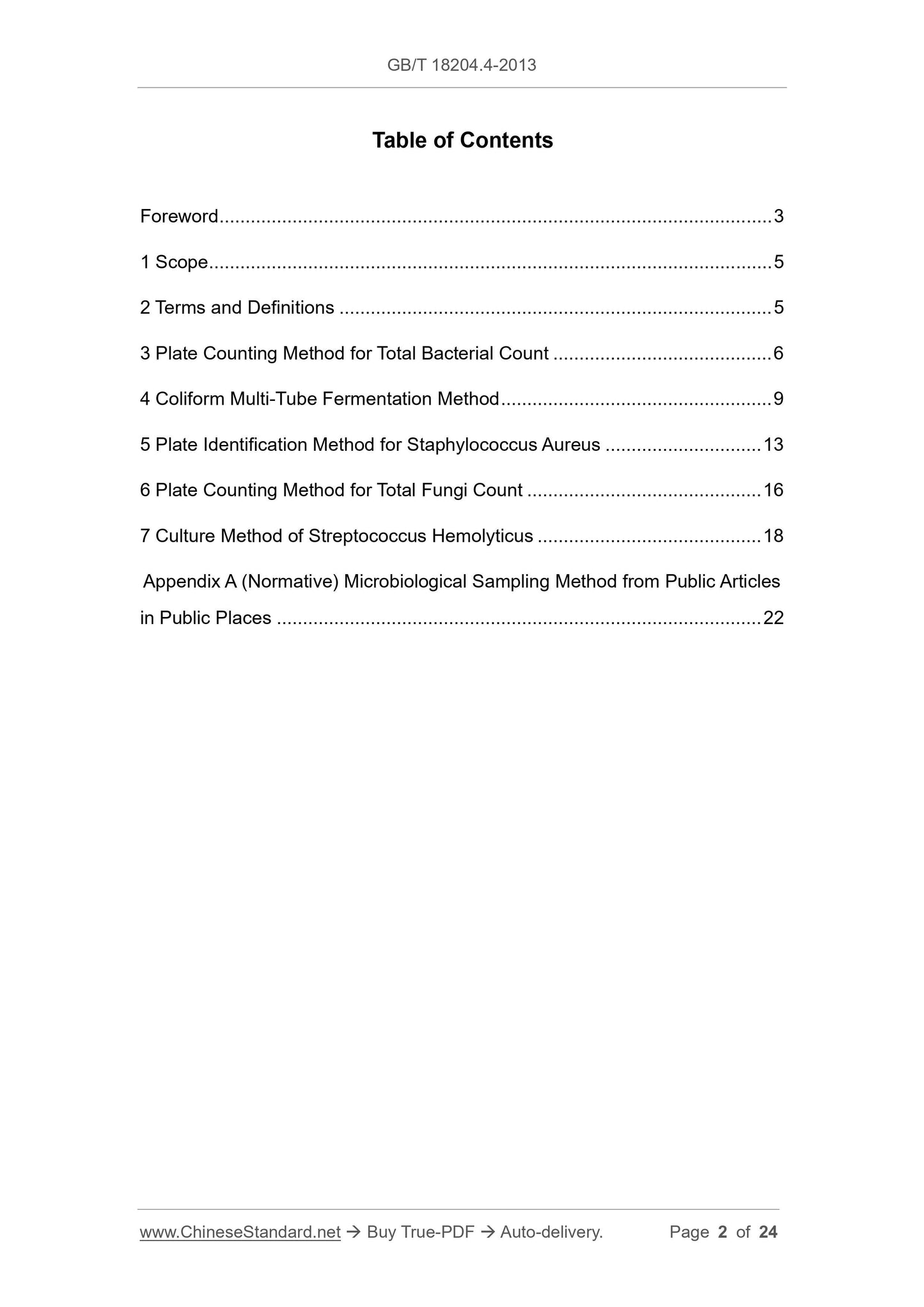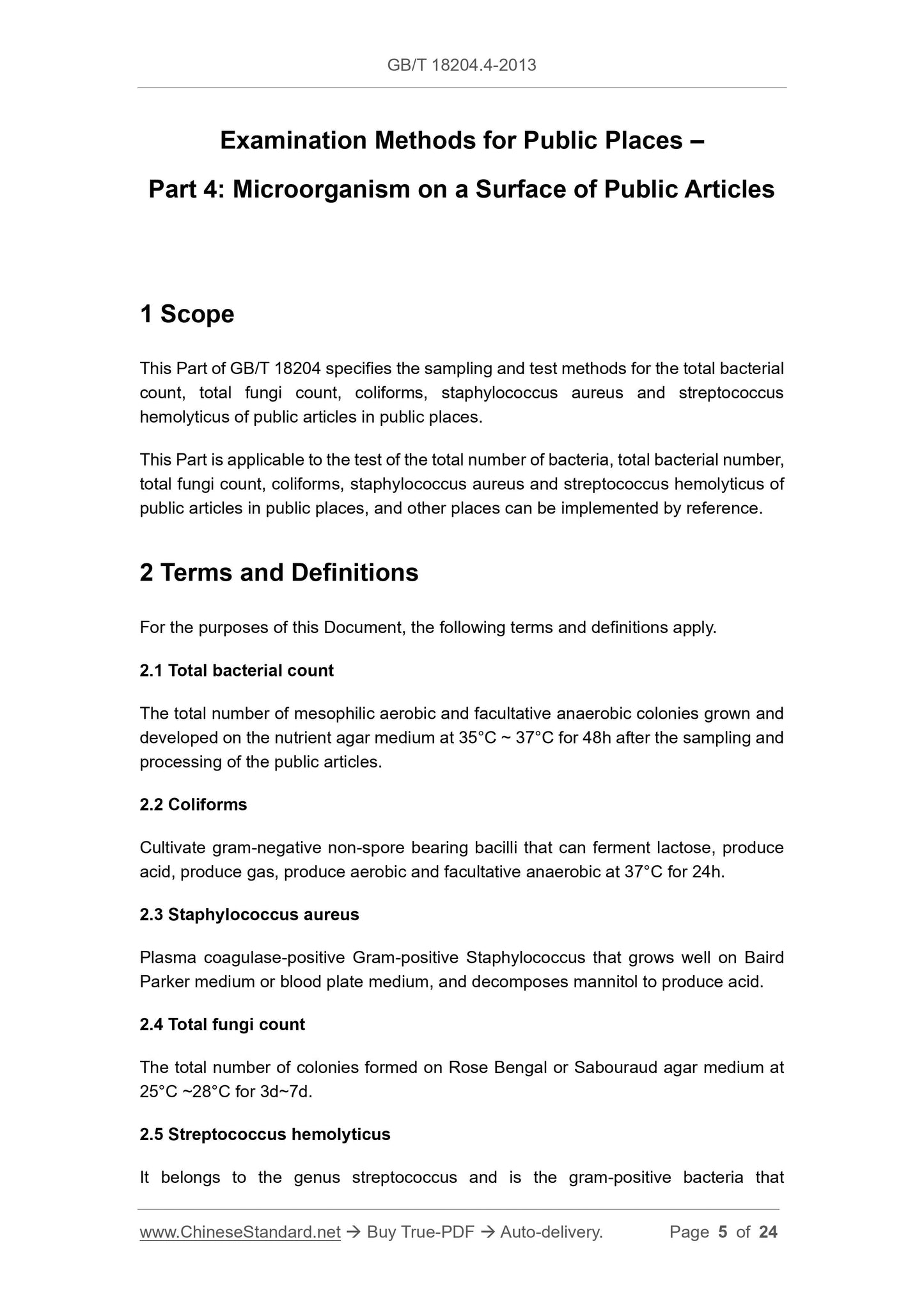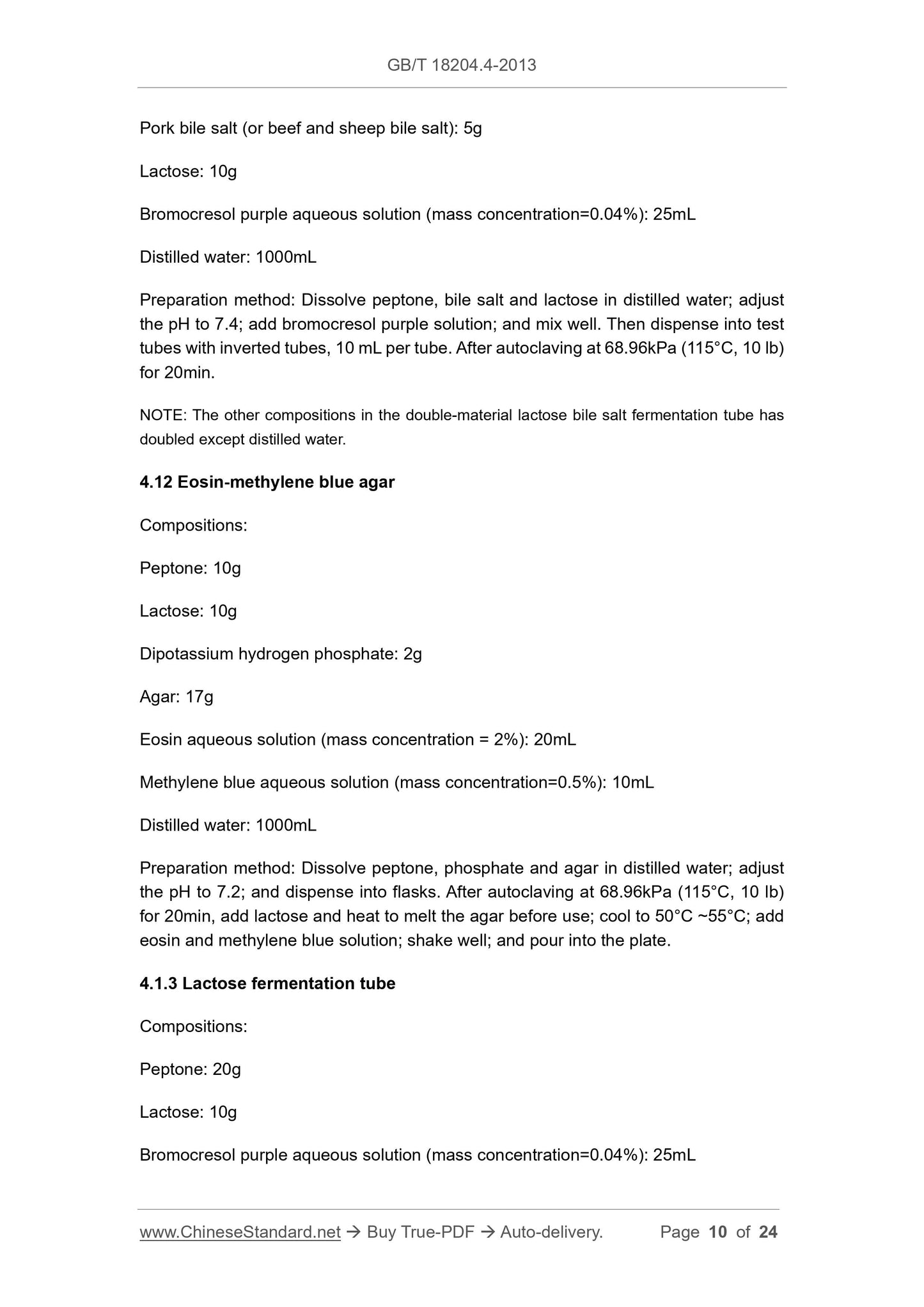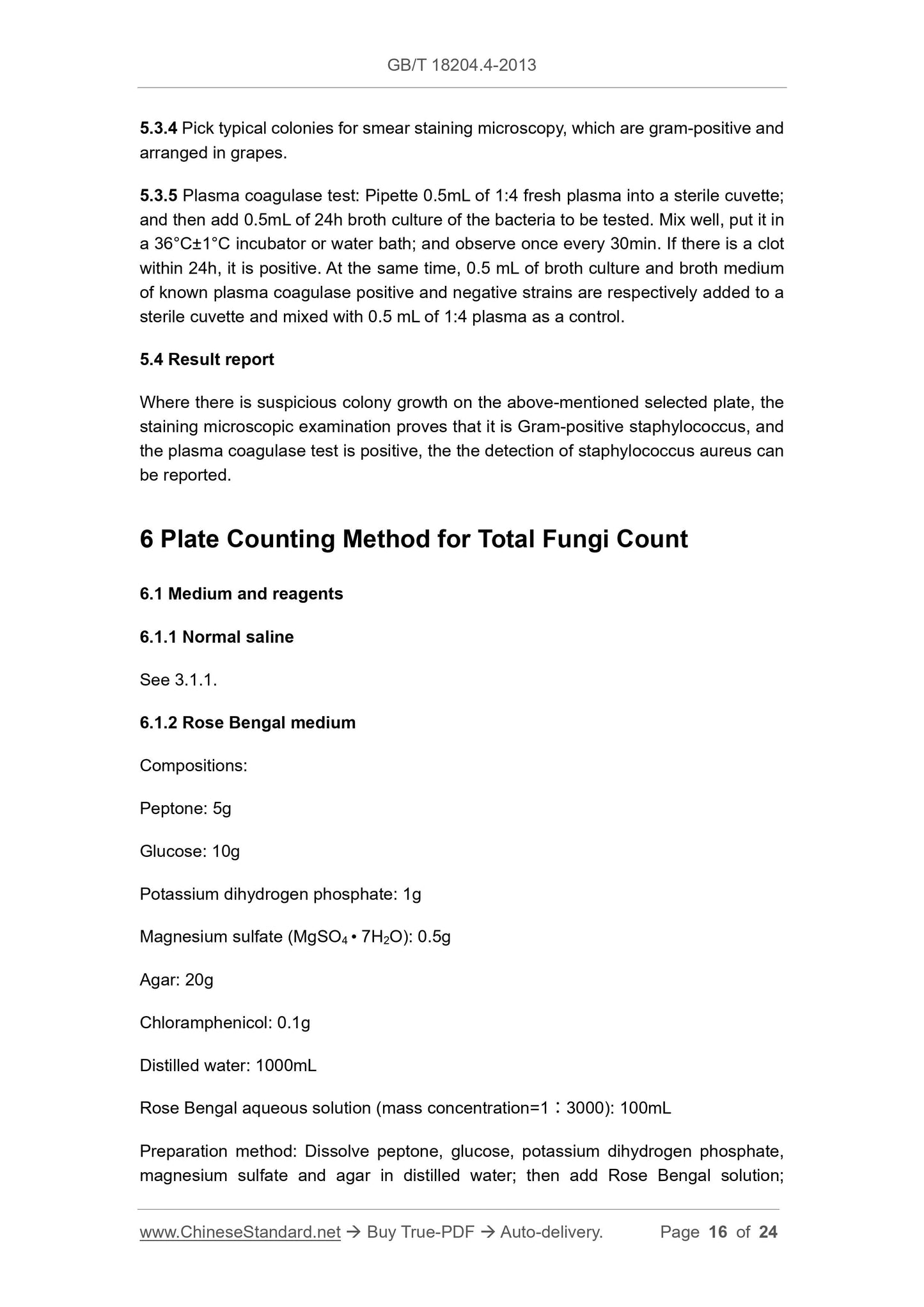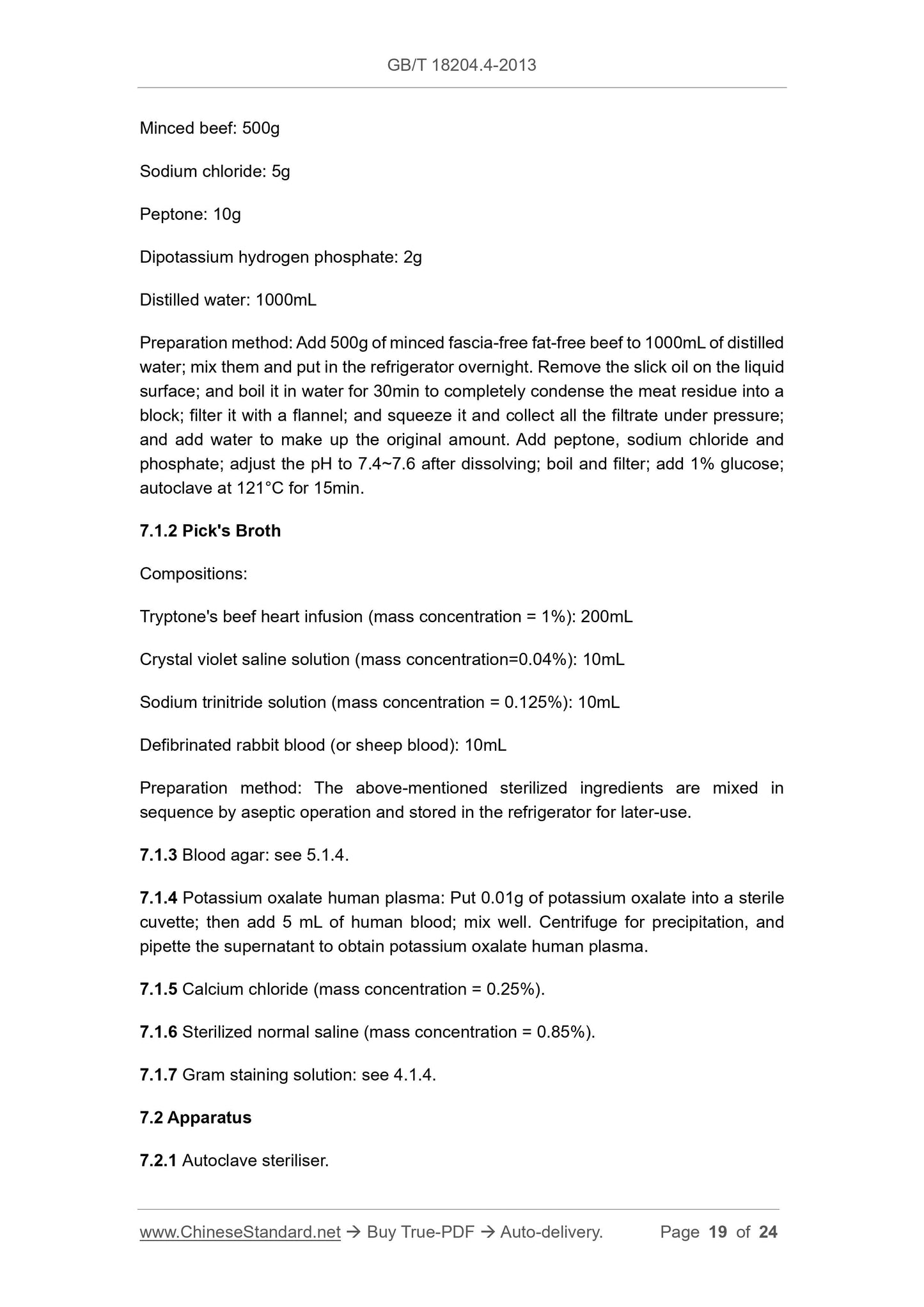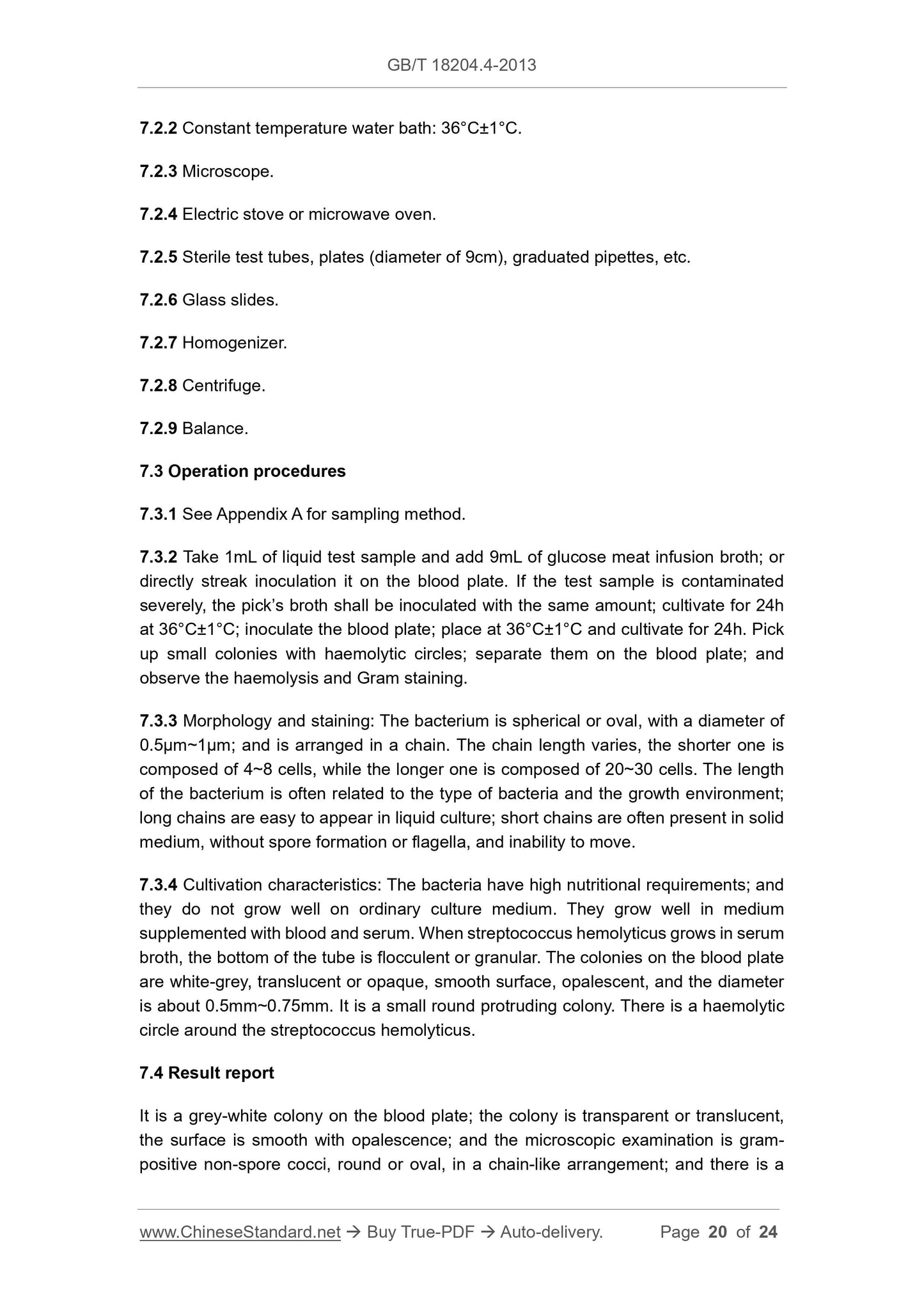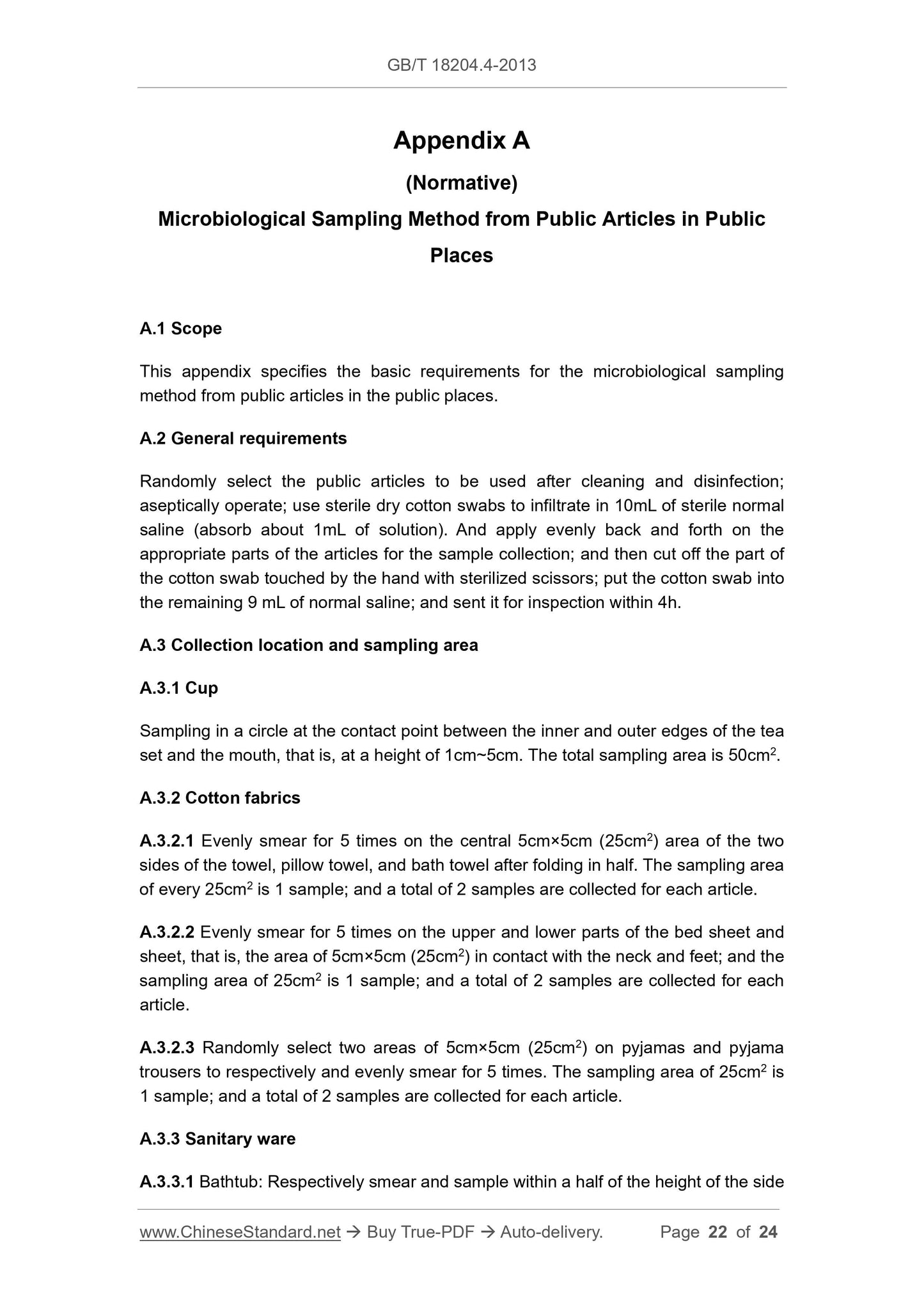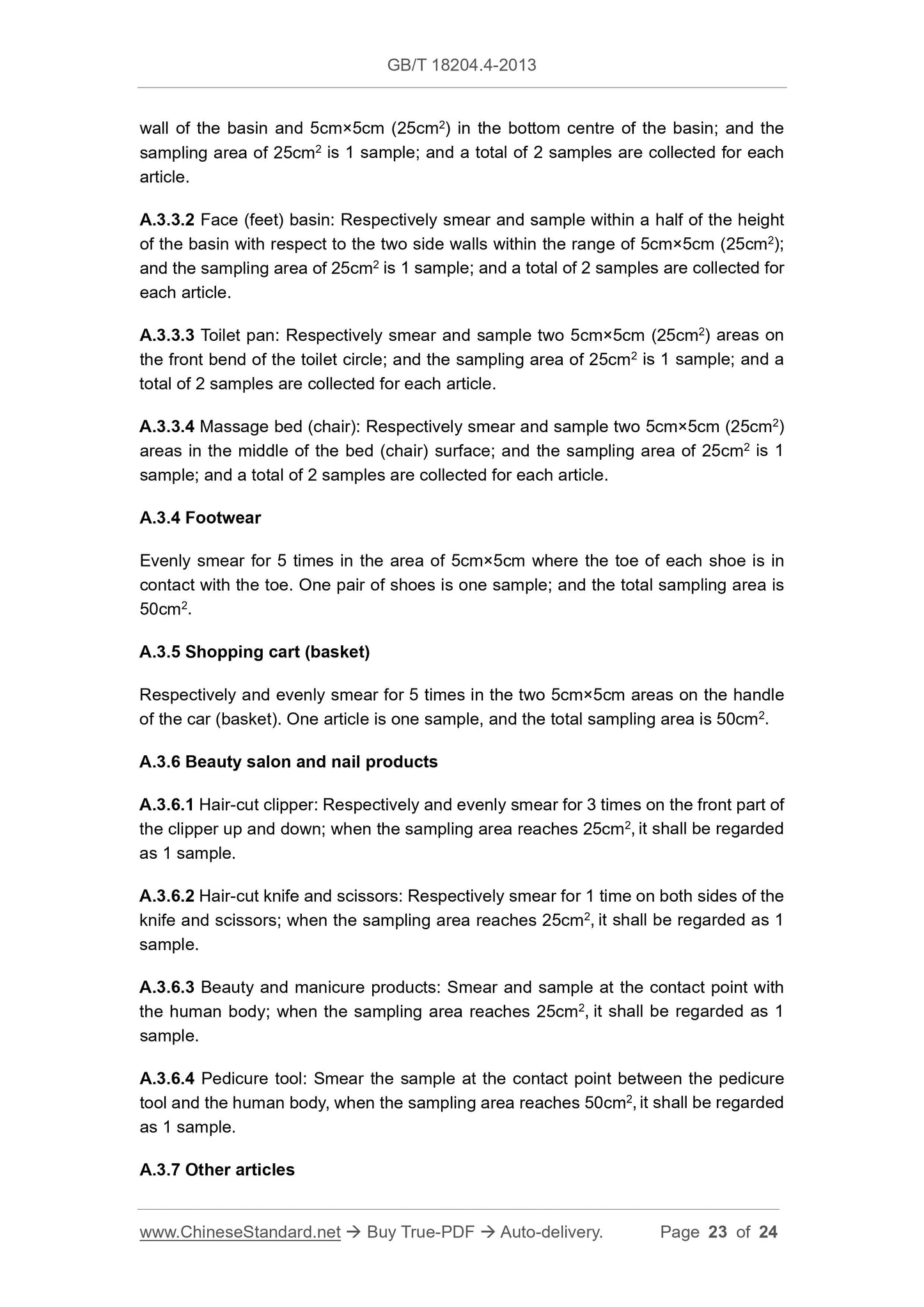1
/
of
9
PayPal, credit cards. Download editable-PDF and invoice in 1 second!
GB/T 18204.4-2013 English PDF (GBT18204.4-2013)
GB/T 18204.4-2013 English PDF (GBT18204.4-2013)
Regular price
$275.00 USD
Regular price
Sale price
$275.00 USD
Unit price
/
per
Shipping calculated at checkout.
Couldn't load pickup availability
Delivery: 3 seconds. Download true-PDF + Invoice.
Get QUOTATION in 1-minute: Click GB/T 18204.4-2013
Historical versions: GB/T 18204.4-2013
Preview True-PDF (Reload/Scroll if blank)
GB/T 18204.4-2013: Examination methods for public places -- Part 4: Microorganism on a surface of public articles
GB/T 18204.4-2013
GB
NATIONAL STANDARD OF THE
PEOPLE’S REPUBLIC OF CHINA
ICS 13.060
C 51
Replacing GB/T 18204.2~18204.8-2000, GB/T 18204.11~18204.12-2000
Partially replacing GB/T 17220-1998
Examination Methods for Public Places –
Part 4: Microorganism on a Surface of Public Articles
ISSUED ON: DECEMBER 31, 2013
IMPLEMENTED ON: DECEMBER 01, 2014
Issued by: General Administration of Quality Supervision, Inspection and
Quarantine;
Standardization Administration of PRC.
Table of Contents
Foreword ... 3
1 Scope ... 5
2 Terms and Definitions ... 5
3 Plate Counting Method for Total Bacterial Count ... 6
4 Coliform Multi-Tube Fermentation Method ... 9
5 Plate Identification Method for Staphylococcus Aureus ... 13
6 Plate Counting Method for Total Fungi Count ... 16
7 Culture Method of Streptococcus Hemolyticus ... 18
Appendix A (Normative) Microbiological Sampling Method from Public Articles
in Public Places ... 22
Examination Methods for Public Places –
Part 4: Microorganism on a Surface of Public Articles
1 Scope
This Part of GB/T 18204 specifies the sampling and test methods for the total bacterial
count, total fungi count, coliforms, staphylococcus aureus and streptococcus
hemolyticus of public articles in public places.
This Part is applicable to the test of the total number of bacteria, total bacterial number,
total fungi count, coliforms, staphylococcus aureus and streptococcus hemolyticus of
public articles in public places, and other places can be implemented by reference.
2 Terms and Definitions
For the purposes of this Document, the following terms and definitions apply.
2.1 Total bacterial count
The total number of mesophilic aerobic and facultative anaerobic colonies grown and
developed on the nutrient agar medium at 35°C ~ 37°C for 48h after the sampling and
processing of the public articles.
2.2 Coliforms
Cultivate gram-negative non-spore bearing bacilli that can ferment lactose, produce
acid, produce gas, produce aerobic and facultative anaerobic at 37°C for 24h.
2.3 Staphylococcus aureus
Plasma coagulase-positive Gram-positive Staphylococcus that grows well on Baird
Parker medium or blood plate medium, and decomposes mannitol to produce acid.
2.4 Total fungi count
The total number of colonies formed on Rose Bengal or Sabouraud agar medium at
25°C ~28°C for 3d~7d.
2.5 Streptococcus hemolyticus
It belongs to the genus streptococcus and is the gram-positive bacteria that
Pork bile salt (or beef and sheep bile salt): 5g
Lactose: 10g
Bromocresol purple aqueous solution (mass concentration=0.04%): 25mL
Distilled water: 1000mL
Preparation method: Dissolve peptone, bile salt and lactose in distilled water; adjust
the pH to 7.4; add bromocresol purple solution; and mix well. Then dispense into test
tubes with inverted tubes, 10 mL per tube. After autoclaving at 68.96kPa (115°C, 10 lb)
for 20min.
NOTE: The other compositions in the double-material lactose bile salt fermentation tube has
doubled except distilled water.
4.12 Eosin-methylene blue agar
Compositions:
Peptone: 10g
Lactose: 10g
Dipotassium hydrogen phosphate: 2g
Agar: 17g
Eosin aqueous solution (mass concentration = 2%): 20mL
Methylene blue aqueous solution (mass concentration=0.5%): 10mL
Distilled water: 1000mL
Preparation method: Dissolve peptone, phosphate and agar in distilled water; adjust
the pH to 7.2; and dispense into flasks. After autoclaving at 68.96kPa (115°C, 10 lb)
for 20min, add lactose and heat to melt the agar before use; cool to 50°C ~55°C; add
eosin and methylene blue solution; shake well; and pour into the plate.
4.1.3 Lactose fermentation tube
Compositions:
Peptone: 20g
Lactose: 10g
Bromocresol purple aqueous solution (mass concentration=0.04%): 25mL
5.3.4 Pick typical colonies for smear staining microscopy, which are gram-positive and
arranged in grapes.
5.3.5 Plasma coagulase test: Pipette 0.5mL of 1:4 fresh plasma into a sterile cuvette;
and then add 0.5mL of 24h broth culture of the bacteria to be tested. Mix well, put it in
a 36°C±1°C incubator or water bath; and observe once every 30min. If there is a clot
within 24h, it is positive. At the same time, 0.5 mL of broth culture and broth medium
of known plasma coagulase positive and negative strains are respectively added to a
sterile cuvette and mixed with 0.5 mL of 1:4 plasma as a control.
5.4 Result report
Where there is suspicious colony growth on the above-mentioned selected plate, the
staining microscopic examination proves that it is Gram-positive staphylococcus, and
the plasma coagulase test is positive, the the detection of staphylococcus aureus can
be reported.
6 Plate Counting Method for Total Fungi Count
6.1 Medium and reagents
6.1.1 Normal saline
See 3.1.1.
6.1.2 Rose Bengal medium
Compositions:
Peptone: 5g
Glucose: 10g
Potassium dihydrogen phosphate: 1g
Magnesium sulfate (MgSO4 • 7H2O): 0.5g
Agar: 20g
Chloramphenicol: 0.1g
Distilled water: 1000mL
Rose Bengal aqueous solution (mass concentration=1∶3000): 100mL
Preparation method: Dissolve peptone, glucose, potassium dihydrogen phosphate,
magnesium sulfate and agar in distilled water; then add Rose Bengal solution;
Minced beef: 500g
Sodium chloride: 5g
Peptone: 10g
Dipotassium hydrogen phosphate: 2g
Distilled water: 1000mL
Preparation method: Add 500g of minced fascia-free fat-free beef to 1000mL of distilled
water; mix them and put in the refrigerator overnight. Remove the slick oil on the liquid
surface; and boil it in water for 30min to completely condense the meat residue into a
block; filter it with a flannel; and squeeze it and collect all the filtrate under pressure;
and add water to make up the original amount. Add peptone, sodium chloride and
phosphate; adjust the pH to 7.4~7.6 after dissolving; boil and filter; add 1% glucose;
autoclave at 121°C for 15min.
7.1.2 Pick's Broth
Compositions:
Tryptone's beef heart infusion (mass concentration = 1%): 200mL
Crystal violet saline solution (mass concentration=0.04%): 10mL
Sodium trinitride solution (mass concentration = 0.125%): 10mL
Defibrinated rabbit blood (or sheep blood): 10mL
Preparation method: The above-mentioned sterilized ingredients are mixed in
sequence by aseptic operation and stored in the refrigerator for later-use.
7.1.3 Blood agar: see 5.1.4.
7.1.4 Potassium oxalate human plasma: Put 0.01g of potassium oxalate into a sterile
cuvette; then add 5 mL of human blood; mix well. Centrifuge for precipitation, and
pipette the supernatant to obtain potassium oxalate human plasma.
7.1.5 Calcium chloride (mass concentration = 0.25%).
7.1.6 Sterilized normal saline (mass concentration = 0.85%).
7.1.7 Gram staining solution: see 4.1.4.
7.2 Apparatus
7.2.1 Autoclave steriliser.
7.2.2 Constant temperature water bath: 36°C±1°C.
7.2.3 Microscope.
7.2.4 Electric stove or microwave oven.
7.2.5 Sterile test tubes, plates (diameter of 9cm), graduated pipettes, etc.
7.2.6 Glass slides.
7.2.7 Homogenizer.
7.2.8 Centrifuge.
7.2.9 Balance.
7.3 Operation procedures
7.3.1 See Appendix A for sampling method.
7.3.2 Take 1mL of liquid test sample and add 9mL of glucose meat infusion broth; or
directly streak inoculation it on the blood plate. If the test sample is contaminated
severely, the pick’s broth shall be inoculated with the same amount; cultivate for 24h
at 36°C±1°C;...
Get QUOTATION in 1-minute: Click GB/T 18204.4-2013
Historical versions: GB/T 18204.4-2013
Preview True-PDF (Reload/Scroll if blank)
GB/T 18204.4-2013: Examination methods for public places -- Part 4: Microorganism on a surface of public articles
GB/T 18204.4-2013
GB
NATIONAL STANDARD OF THE
PEOPLE’S REPUBLIC OF CHINA
ICS 13.060
C 51
Replacing GB/T 18204.2~18204.8-2000, GB/T 18204.11~18204.12-2000
Partially replacing GB/T 17220-1998
Examination Methods for Public Places –
Part 4: Microorganism on a Surface of Public Articles
ISSUED ON: DECEMBER 31, 2013
IMPLEMENTED ON: DECEMBER 01, 2014
Issued by: General Administration of Quality Supervision, Inspection and
Quarantine;
Standardization Administration of PRC.
Table of Contents
Foreword ... 3
1 Scope ... 5
2 Terms and Definitions ... 5
3 Plate Counting Method for Total Bacterial Count ... 6
4 Coliform Multi-Tube Fermentation Method ... 9
5 Plate Identification Method for Staphylococcus Aureus ... 13
6 Plate Counting Method for Total Fungi Count ... 16
7 Culture Method of Streptococcus Hemolyticus ... 18
Appendix A (Normative) Microbiological Sampling Method from Public Articles
in Public Places ... 22
Examination Methods for Public Places –
Part 4: Microorganism on a Surface of Public Articles
1 Scope
This Part of GB/T 18204 specifies the sampling and test methods for the total bacterial
count, total fungi count, coliforms, staphylococcus aureus and streptococcus
hemolyticus of public articles in public places.
This Part is applicable to the test of the total number of bacteria, total bacterial number,
total fungi count, coliforms, staphylococcus aureus and streptococcus hemolyticus of
public articles in public places, and other places can be implemented by reference.
2 Terms and Definitions
For the purposes of this Document, the following terms and definitions apply.
2.1 Total bacterial count
The total number of mesophilic aerobic and facultative anaerobic colonies grown and
developed on the nutrient agar medium at 35°C ~ 37°C for 48h after the sampling and
processing of the public articles.
2.2 Coliforms
Cultivate gram-negative non-spore bearing bacilli that can ferment lactose, produce
acid, produce gas, produce aerobic and facultative anaerobic at 37°C for 24h.
2.3 Staphylococcus aureus
Plasma coagulase-positive Gram-positive Staphylococcus that grows well on Baird
Parker medium or blood plate medium, and decomposes mannitol to produce acid.
2.4 Total fungi count
The total number of colonies formed on Rose Bengal or Sabouraud agar medium at
25°C ~28°C for 3d~7d.
2.5 Streptococcus hemolyticus
It belongs to the genus streptococcus and is the gram-positive bacteria that
Pork bile salt (or beef and sheep bile salt): 5g
Lactose: 10g
Bromocresol purple aqueous solution (mass concentration=0.04%): 25mL
Distilled water: 1000mL
Preparation method: Dissolve peptone, bile salt and lactose in distilled water; adjust
the pH to 7.4; add bromocresol purple solution; and mix well. Then dispense into test
tubes with inverted tubes, 10 mL per tube. After autoclaving at 68.96kPa (115°C, 10 lb)
for 20min.
NOTE: The other compositions in the double-material lactose bile salt fermentation tube has
doubled except distilled water.
4.12 Eosin-methylene blue agar
Compositions:
Peptone: 10g
Lactose: 10g
Dipotassium hydrogen phosphate: 2g
Agar: 17g
Eosin aqueous solution (mass concentration = 2%): 20mL
Methylene blue aqueous solution (mass concentration=0.5%): 10mL
Distilled water: 1000mL
Preparation method: Dissolve peptone, phosphate and agar in distilled water; adjust
the pH to 7.2; and dispense into flasks. After autoclaving at 68.96kPa (115°C, 10 lb)
for 20min, add lactose and heat to melt the agar before use; cool to 50°C ~55°C; add
eosin and methylene blue solution; shake well; and pour into the plate.
4.1.3 Lactose fermentation tube
Compositions:
Peptone: 20g
Lactose: 10g
Bromocresol purple aqueous solution (mass concentration=0.04%): 25mL
5.3.4 Pick typical colonies for smear staining microscopy, which are gram-positive and
arranged in grapes.
5.3.5 Plasma coagulase test: Pipette 0.5mL of 1:4 fresh plasma into a sterile cuvette;
and then add 0.5mL of 24h broth culture of the bacteria to be tested. Mix well, put it in
a 36°C±1°C incubator or water bath; and observe once every 30min. If there is a clot
within 24h, it is positive. At the same time, 0.5 mL of broth culture and broth medium
of known plasma coagulase positive and negative strains are respectively added to a
sterile cuvette and mixed with 0.5 mL of 1:4 plasma as a control.
5.4 Result report
Where there is suspicious colony growth on the above-mentioned selected plate, the
staining microscopic examination proves that it is Gram-positive staphylococcus, and
the plasma coagulase test is positive, the the detection of staphylococcus aureus can
be reported.
6 Plate Counting Method for Total Fungi Count
6.1 Medium and reagents
6.1.1 Normal saline
See 3.1.1.
6.1.2 Rose Bengal medium
Compositions:
Peptone: 5g
Glucose: 10g
Potassium dihydrogen phosphate: 1g
Magnesium sulfate (MgSO4 • 7H2O): 0.5g
Agar: 20g
Chloramphenicol: 0.1g
Distilled water: 1000mL
Rose Bengal aqueous solution (mass concentration=1∶3000): 100mL
Preparation method: Dissolve peptone, glucose, potassium dihydrogen phosphate,
magnesium sulfate and agar in distilled water; then add Rose Bengal solution;
Minced beef: 500g
Sodium chloride: 5g
Peptone: 10g
Dipotassium hydrogen phosphate: 2g
Distilled water: 1000mL
Preparation method: Add 500g of minced fascia-free fat-free beef to 1000mL of distilled
water; mix them and put in the refrigerator overnight. Remove the slick oil on the liquid
surface; and boil it in water for 30min to completely condense the meat residue into a
block; filter it with a flannel; and squeeze it and collect all the filtrate under pressure;
and add water to make up the original amount. Add peptone, sodium chloride and
phosphate; adjust the pH to 7.4~7.6 after dissolving; boil and filter; add 1% glucose;
autoclave at 121°C for 15min.
7.1.2 Pick's Broth
Compositions:
Tryptone's beef heart infusion (mass concentration = 1%): 200mL
Crystal violet saline solution (mass concentration=0.04%): 10mL
Sodium trinitride solution (mass concentration = 0.125%): 10mL
Defibrinated rabbit blood (or sheep blood): 10mL
Preparation method: The above-mentioned sterilized ingredients are mixed in
sequence by aseptic operation and stored in the refrigerator for later-use.
7.1.3 Blood agar: see 5.1.4.
7.1.4 Potassium oxalate human plasma: Put 0.01g of potassium oxalate into a sterile
cuvette; then add 5 mL of human blood; mix well. Centrifuge for precipitation, and
pipette the supernatant to obtain potassium oxalate human plasma.
7.1.5 Calcium chloride (mass concentration = 0.25%).
7.1.6 Sterilized normal saline (mass concentration = 0.85%).
7.1.7 Gram staining solution: see 4.1.4.
7.2 Apparatus
7.2.1 Autoclave steriliser.
7.2.2 Constant temperature water bath: 36°C±1°C.
7.2.3 Microscope.
7.2.4 Electric stove or microwave oven.
7.2.5 Sterile test tubes, plates (diameter of 9cm), graduated pipettes, etc.
7.2.6 Glass slides.
7.2.7 Homogenizer.
7.2.8 Centrifuge.
7.2.9 Balance.
7.3 Operation procedures
7.3.1 See Appendix A for sampling method.
7.3.2 Take 1mL of liquid test sample and add 9mL of glucose meat infusion broth; or
directly streak inoculation it on the blood plate. If the test sample is contaminated
severely, the pick’s broth shall be inoculated with the same amount; cultivate for 24h
at 36°C±1°C;...
Share
